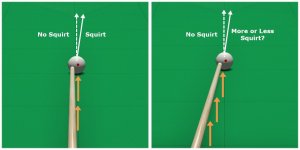The pics below show the same cue hitting the CB on the same spot while traveling in the same direction.
The cue on the left is stroked normally, straight ahead parallel with the CB's no-squirt path (the dotted white arrow).
The cue on the right is also stroked parallel with the CB's no-squirt path, but with the cue angled as shown (don't ask me how to do that; this is a thought experiment ).
).
Which one produces more squirt?
pj <- not a quiz - I don't know the answer
chgo
View attachment 63025
The cue on the left is stroked normally, straight ahead parallel with the CB's no-squirt path (the dotted white arrow).
The cue on the right is also stroked parallel with the CB's no-squirt path, but with the cue angled as shown (don't ask me how to do that; this is a thought experiment
Which one produces more squirt?
pj <- not a quiz - I don't know the answer
chgo
View attachment 63025
Attachments
Last edited:
